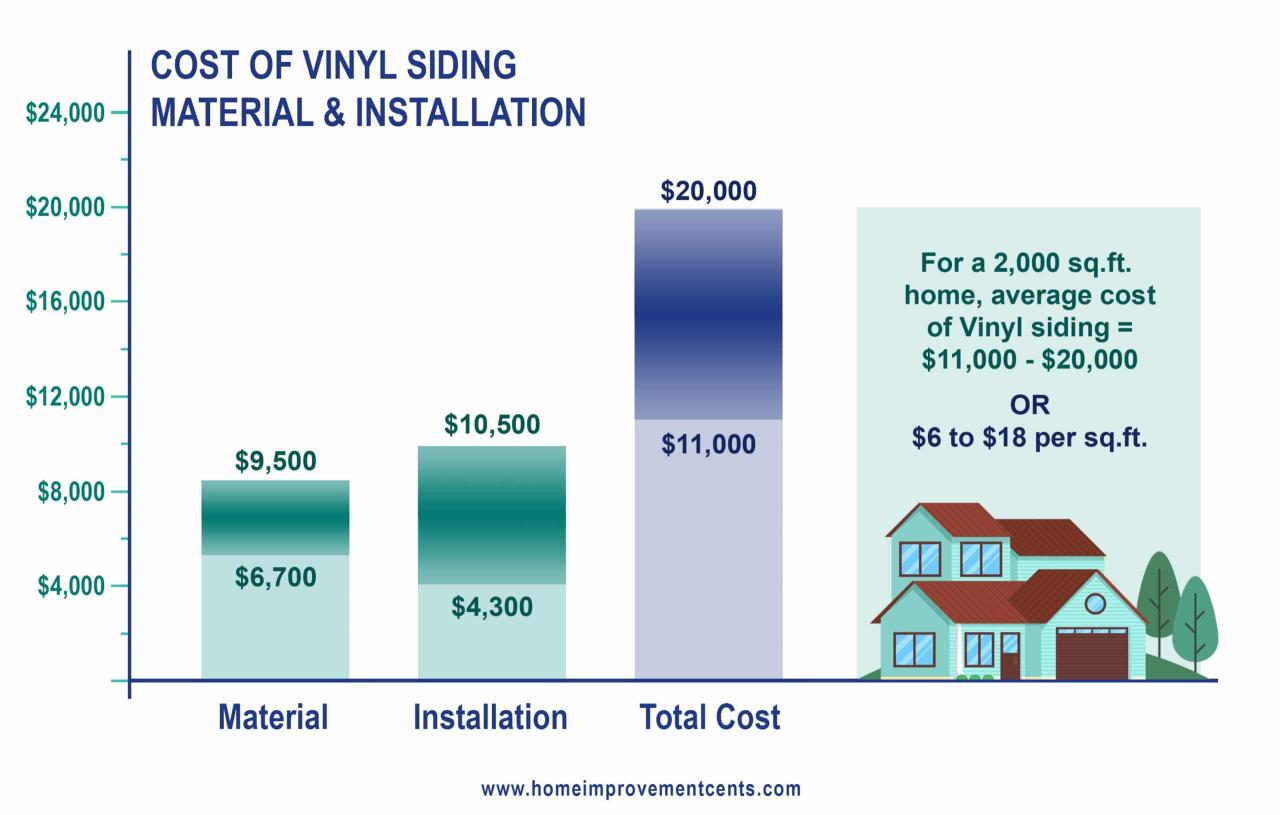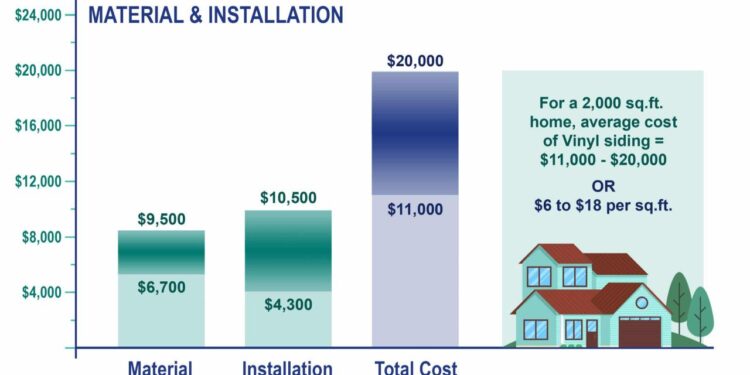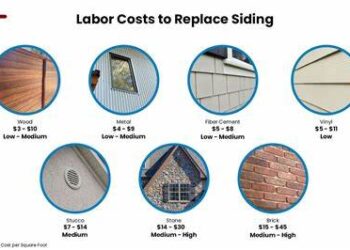Vinyl siding estimate cost is a crucial aspect of any home improvement project. Understanding the factors that influence the cost, how to estimate accurately, and the pros and cons of DIY versus professional installation can help homeowners make informed decisions.
Dive into this guide to gain valuable insights on managing vinyl siding costs effectively.


Factors Affecting Vinyl Siding Cost
When considering the cost of vinyl siding for your home, there are several key factors that can impact the overall estimate. These factors can vary depending on the type of vinyl siding chosen, the quality of materials, the size and complexity of the house, as well as the location and labor costs involved.Types of Vinyl Siding
There are different types of vinyl siding available in the market, ranging from basic options to premium choices. The type of vinyl siding you choose will directly affect the cost of the project. More durable and aesthetically pleasing options will typically come at a higher price point.Quality of Materials
The quality of the vinyl siding materials used can significantly impact the overall cost. Higher-quality materials tend to be more expensive but offer better durability and long-term performance. Cheaper materials may save you money upfront but could result in higher maintenance costs in the future.House Size and Complexity
The size and complexity of your home will also play a role in determining the cost of the vinyl siding project. Larger homes will require more materials and labor, leading to higher estimates. Additionally, houses with intricate designs or multiple stories may require additional time and expertise, further increasing the overall cost.Location and Labor Costs
The location of your home and the prevailing labor costs in your area can impact the final estimate for vinyl siding installation. Areas with higher living costs or where skilled labor is in high demand may result in higher labor costs. Additionally, factors such as accessibility to the site and local building codes can also influence the overall cost.Estimating Vinyl Siding Cost
When planning a vinyl siding project, it is essential to have a clear understanding of the cost involved. Estimating the vinyl siding cost accurately will help you budget effectively and avoid any surprises along the way.To calculate the amount of vinyl siding needed for a project, follow these steps:Determining Vinyl Siding Quantity
- Start by measuring the height and width of each wall where siding will be installed.
- Calculate the square footage of each wall by multiplying the height by the width.
- Add up the square footage of all walls to get the total square footage needed for siding.
- Consider ordering an additional 10% to account for any waste or mistakes during installation.
Including Additional Materials
- Insulation: Improves energy efficiency and protects against moisture. Factor in the square footage of walls when calculating insulation needs.
- Trim: Provides a finished look to corners, windows, and doors. Measure the linear footage required for trim pieces.
- Accessories: Items like J-channels, soffit, and fascia are essential for a complete siding installation. Include these in your material list and cost estimate.
Getting Accurate Quotes
- Request quotes from multiple contractors to compare pricing and services offered.
- Ask about the type and quality of materials they plan to use for the siding project.
- Inquire about warranties, project timeline, and any additional costs that may arise during installation.
Comparing Estimates
- Review each estimate carefully and ensure all aspects of the project are covered.
- Compare the breakdown of costs, including materials, labor, and any additional fees.
- Check for any discrepancies or missing details that could impact the final outcome of the project.
DIY vs. Professional Installation
When it comes to vinyl siding installation, homeowners often face the decision of whether to tackle the project themselves or hire professionals. This choice can significantly impact the overall cost and quality of the installation.Cost Comparison
DIY installation typically saves on labor costs, as you won't be paying for professional services. However, it's essential to consider the hidden costs, such as tools, equipment, and potential mistakes that may require additional materials. On the other hand, hiring professionals comes with a higher upfront cost, but it ensures quality workmanship and may save you money in the long run by avoiding costly errors.Pros and Cons
- DIY Installation:Pros - Cost-effective in terms of labor, gives you control over the project timeline, and can be a rewarding experience. Cons - Risk of mistakes leading to additional expenses, lack of expertise compared to professionals, and may void warranties on materials.
- Professional Installation:Pros - Ensures quality work, saves time and effort, provides warranty coverage, and reduces the risk of errors. Cons - Higher upfront cost, less flexibility in project scheduling, and reliance on external contractors.
Tips for DIY Installation
- Invest in quality tools to ensure precise cuts and proper installation.
- Follow manufacturer guidelines and installation instructions carefully to avoid mistakes.
- Start with a small section to practice before tackling the entire project.
- Consider attending workshops or seeking advice from professionals for guidance.
Risks of DIY Installation
- Improper installation can lead to water damage, moisture buildup, or mold growth.
- Inaccurate measurements or cutting errors may result in material waste and additional costs.
- DIY mistakes could void warranties on vinyl siding products, leading to out-of-pocket expenses for replacements.
Additional Cost Factors to Consider
When budgeting for vinyl siding installation, it's crucial to account for various additional cost factors that can impact the overall price. These factors can often be overlooked but are essential to consider to avoid unexpected expenses and ensure a successful project.Permits and Regulations
- Obtaining permits for vinyl siding installation can add to the total cost. The cost of permits varies depending on your location and the scope of the project.
- Complying with local building codes and regulations may also require specific materials or installation methods, affecting the overall cost.
Waste Disposal Fees
- Disposing of old siding material and waste generated during the installation process may involve additional fees. It's essential to factor in waste disposal costs when planning your budget.
- Rental fees for dumpsters or hauling services might be necessary, depending on the amount of waste produced.
Potential Repairs
- If there are underlying issues with the existing structure of your home, such as rot or water damage, these repairs will need to be addressed before installing vinyl siding. Repair costs can significantly impact the total project cost.
- Identifying and fixing any structural issues early on can prevent future problems and ensure the longevity of your vinyl siding.
Maintenance and Long-Term Durability
- While vinyl siding is known for its low maintenance requirements, periodic upkeep such as cleaning and inspection should be factored into the total cost over time.
- Considering the long-term durability of vinyl siding can help you assess its value and overall cost-effectiveness compared to other materials.
Budgeting for Unexpected Expenses
- Set aside a contingency fund for unforeseen costs that may arise during the installation process. This can include unexpected repairs, material shortages, or other surprises.
- Having a buffer in your budget can provide peace of mind and ensure that your vinyl siding installation project stays on track without financial strain.













